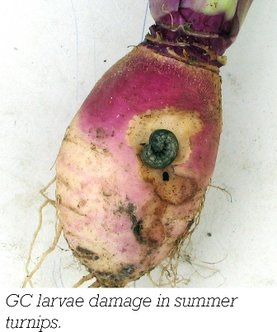Greasy cutworm
Agrotis ipsilon aneituma
Greasy cutworm (GC) is found in open areas below the snowline throughout NZ. Although generally considered a minor pest, it can be a serious problem in some field crops.
Identification
Adult GC are brown to greyish brown moths with darker patches on the forewings and a wingspan of around 50 mm. The peak moth population occurs between October and April, but they can be seen year-round.
The larvae appear greasy, ranging in colour from light grey to dark brown, and are 50 mm in length when fully grown. During the day they lie in burrows just below the soil surface, and emerge at night to feed. This species normally overwinters in the soil as pupae, although some larvae overwinter in warmer areas.

Prevention and management
There can be up to three generations per year in warmer areas, but only two in cooler areas, with each lasting for 4-28 weeks depending on climate, locality and feed supply.
The main period of activity for GC is October to April. Although an insecticide can give adequate protection against GC, prevention through clean cultivation and good weed control also help to keep this pest at low levels.
The use of a granular insecticide sown with the seed or later worked into the top 15 cm of soil is the best method of controlling this pest.

